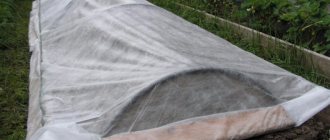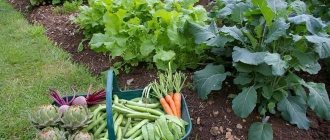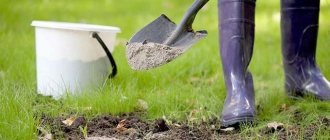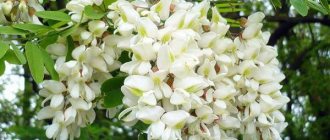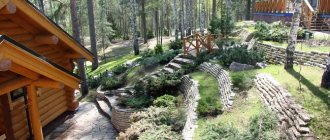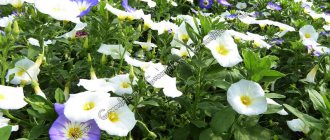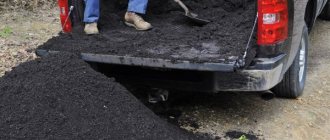Methods of strengthening
In relatively flat areas there are ravines and hills, heterogeneity of micro- and mesorelief. In such areas, problems often arise associated with landslides and soil washout from slopes. Both linear and planar water erosion can cause great damage to the soil cover. A particular danger threatens unturfed slopes, which lack not only trees and shrubs, but also herbaceous vegetation.
There are quite a few ways to counteract erosion phenomena.
- On steep slopes, a system of flat terraces with retaining walls is installed.
- One of the effective methods of strengthening slopes can be the creation of a rock garden or rocky hill, while terracing the slope is complemented by planting soil-fixing ornamental plants.
- At large angles of inclination, metal gabion meshes filled with stone, as well as geogrids, cellular geogrids and geomats, into which mixtures of lawn grasses are sown, help.
But still, one of the most environmentally friendly ways to combat erosion processes is to stabilize the slopes by planting trees and shrubs that form a well-developed root system. This method is most effective when the slope is less than 25–30%. However, even on steeper slopes it is possible to plant using geogrid or geogrid, which helps to further strengthen the soil.
The mentioned method is used for afforestation of large areas in rugged terrain, for strengthening slopes during road construction, and for landscaping park areas and personal plots.
An example of the use of phytoplasty
Stabilizing slopes by planting trees and shrubs is an area of activity in which knowledge in the field of engineering biology and ecology, landscape design and dendrology may be necessary.
So, what plants will help stabilize the soil on slopes?
LAND ON A SLOPE - PROBLEM SOLVING: VIDEO
Video » Plot with a Slope. Problem solving". Category "estate for the soul"
© Author: D. Kolesov
TOOLS FOR CRAFTSMAN AND CRAFTSMAN, AND HOUSEHOLD GOODS VERY CHEAP. FREE SHIPPING. THERE ARE REVIEWS.
Below are other entries on the topic “How to do it yourself - for a homeowner!”
- How to plant landscaping on a slope Landscaping a site on a slope Every summer resident…
- DIY garden on a slope - terracing, water drainage and plants for it GARDENS ON SLOPE - BEAUTY...
- How to arrange a garden on a small plot - an example and a master class from a landscape designer GARDEN ON A SMALL PLOT How to arrange...
- Arrangement of a site on a slope - paths and retaining walls with your own hands PATHWAYS ON A SLOPE WITH YOUR OWN HANDS EARLIER...
- Do-it-yourself pond on a sloped plot (south side) Plot on a southern slope -…
- Do-it-yourself narrow beds + vegetable combination table for them Narrow joint beds are the best…
- Strengthening a slope on a plot or dacha HOW TO STRENGTHEN A SLOPEN AT A dacha Are you dreaming...
Subscribe to updates in our groups and share.
Let's be friends!
With your own hands › Dacha garden and vegetable garden › How to decorate a garden › Plot on a slope - strengthening and landscaping, what to plant
Volumetric root system
First of all, these are woody species with a branched, fairly voluminous root system, such as
- mountain ash,
- intermediate rowan,
- small-leaved linden,
- tall ash.
Strong fibrous roots that bind the soil well form:
- common bird cherry,
- Norway maple,
- field maple,
- ash maple,
- red maple and some others,
- most elms and beech trees.
Under certain conditions, the fibrous root system is also laid by common horse chestnut, silver birch and downy birch, and some coniferous species: common larch, Scots pine, some fir trees, although it should be noted that the nature of the root system in these species varies significantly.
A site with even a slight difference in relief can be transformed by a retaining wall decorated with perennials
To a lesser extent, plants with a taproot system, which, although going deep into the soil, are poorly branched, can solve this problem. These include:
- English oak and some other types of oak,
- black alder,
- Amur velvet,
- nuts,
- many hawthorns,
- pseudotuga Menzies,
- on soils with a light granulometric composition - apple, pear and plum trees.
Choosing plants for cliffs and slopes
The primary task in landscaping a sloping area is to assess the existing relief. If the angle of inclination of some segments is more than 30 degrees, it would not hurt to smooth them out - at least a little, in order to prevent active erosion of the top soil layer and the rapid removal of moisture from it every time after manual watering or rain. Once you've solved the problem of retaining moisture and slowing erosion, it's time to further evaluate the area for use, zone your site, and plan what types of plants to place there.
The genus, type and varietal qualities of the plantings you choose should take into account not only your visual and economic preferences, but also the atmospheric and soil characteristics of your region. Deep-rooted greens eliminate excessive dust and help stabilize unstable soil; trees visually increase the size of the hill and provide life-giving shade, and low-growing creeping covers prevent excessive evaporation of moisture, hide unsightly rocky areas and minimize maintenance.
Grass is often the first choice for problem areas, but allowance must be made for maintenance difficulties. It is difficult to mow, and the sight of withered grass will not please anyone. Rainwater alone, especially flowing down quickly, is not enough for plants with high moisture requirements, and additional watering at higher elevations is difficult to organize. A more reasonable option is a combination of several types of plants. They must either support and protect each other, or have the ability to independently cope with bad conditions such as strong winds and periodic droughts. And have widely branching root systems that allow you to stay on the slope. The less maintenance the better for you, so keep this in mind when selecting vegetation for problem areas.
Superficial root system
Species with shallow, underdeveloped roots effectively fix only the upper soil horizons on slopes, reducing the threat of erosion, but doing little to reduce the risk of landslides. This group of trees and shrubs includes:
- many ate
- poplars,
- aspen,
- red oak,
- white acacia,
- different types of serviceberry.
Shallow roots are also noted:
- at the Japanese scarlet,
- silver maple,
- maple Ginnala,
- cypress trees,
- thuja occidentalis,
- hemlock,
- at the goat willow,
- brittle willow,
- white willow and many others, but this “disadvantage” is more than compensated by their high growth activity.
It is important to know
Plants with flat, shallow root systems are usually more susceptible to wind damage and may also suffer from lack of soil moisture, which is often observed on slopes. All this somewhat limits their use for soil consolidation.
Organizing a trail system on slopes can replace terracing
FLOWER GARDEN ON A SLOPE WITH YOUR HANDS
Flower beds on the slopes always look unusually impressive and picturesque
, resembling colorful carpets smoothly descending to the foot of the hills.
The main problem is to choose the right plants, taking into account the orientation of the slope relative to the cardinal directions.
The southern and southwestern slopes are the warmest and lightest. They are well warmed up by the sun, and the snow melts faster here. But in summer such places, as a rule, suffer from drought and therefore are not suitable for all plants. Conditions on such slopes are favorable for sedum, catnip, sandy and gray carnation, loosestrife, sunflower, milkweed, eschscholzia, and iberis.
Sunflower, or helianthemum monetalis, is a branched subshrub up to 40 cm high. Heavily pubescent stems are erect or prostrate. The leaves are oval or lanceolate, green on top and grayish-tomentose on the underside. Yellow flowers up to 2.5 cm in diameter form beautiful curls.
The slope facing southeast is also well lit by the sun, but the soil here retains moisture longer. These seemingly comfortable conditions are very insidious. Plants awaken early in the spring, their above-ground part warms itself under the sun's rays, and the root area is under the yet-to-melt snow. This slope is ideal for creating a rock garden. Daylily, iris, Volzhanka, edelweiss, and primrose will feel good here.
Volzhanka Kamchatka is a herbaceous unpretentious perennial plant 0.5-1.5 m high. The leaves are narrow, oval or oval-rounded, double-pinnate. Large white lush panicle inflorescences with a diameter of about 20 cm. The plant has a strong root system.
The eastern slope is well illuminated by the morning sun, which does not overheat the soil, and the shadow comes here in the afternoon. In such conditions, astilbe, aquilegia, dicentra, and bergenia will grow well.
Dicentra splendid is a herbaceous perennial that forms a powerful bush about 1 m high. The branched shoots bear pinnately dissected leaves. They are green on top and bluish on the underside. Arc-shaped inflorescences in the form of simple one-sided racemes can reach 20 cm. The flowers have the shape of a heart, cut in two. On long stems, the flowers look like hanging pendants.
The western slope is usually very windy. As a result, the soil dries out faster. Therefore, for planting it is better to choose drought-resistant plants that are not afraid of winds and drafts. Saxifraga, loosestrife, jasmine, Waldsteinia, and periwinkle will take root well here.
Waldsteinia gravilatifolia is an unpretentious ground cover plant up to 30 cm high. It grows well, but does not suppress other plants. The leaves are alternate, dark green. The flowers are lemon-yellow, five-petaled, about 2 cm in diameter, collected in small branched inflorescences.
For a flower garden on the northern slope, moisture-loving and shade-tolerant plants are ideal, since the moisture in this place evaporates slowly and shade reigns here most of the day. Hoofweed, columbine, meadowsweet, phlox, aconite, buzulnik, heuchera, fern, and tiarella will feel comfortable on the northern slope.
Shrubs
Many shrubs have a fairly powerful and branched root system:
- honeysuckle,
- suckers,
- and you,
- spirea,
- privet,
- barberries.
They are also successfully used to fix slopes:
- caragana tree,
- aralia,
- bladderworts,
- derens,
- rose hips.
The slope is decorated and strengthened with wild roses
To strengthen and decorate steep slopes and retaining walls, planting creeping and creeping shrubs, as well as thicket-type perennials, which help create a dense or even continuous ground cover, are widely used.
Among the shrubs that will look most natural and decorative in such an environment, you should choose forms with a crown spread out or pressed to the ground, such as creeping willow and rock willow, horizontal cotoneaster and tiny cotoneaster, Thunberg barberry 'Green Carpet' or stephanandra incisifolia.
DRAINAGE SYSTEM ON A SLOPE
Spring floods and heavy rains are the most dangerous enemies of slopes. Arranging a drainage system will help solve this problem.
For small slopes, as a rule, it is sufficient to install a drainage layer consisting of coarse sand and fine gravel. Steep slopes require a more complex drainage system of gutters or drainage pipes. When erecting a retaining wall in its lower part, it is also necessary to provide a water drainage system. The easiest way to arrange drainage is to make drainage holes in the wall or install pipes with a diameter of about 10 cm into it.
Important Details
The greatest anti-erosion effect is usually achieved by row planting across a slope , however, for decorative purposes, trees and shrubs can be planted in separate picturesque groups.
It is important to know
It should be taken into account that the nature of the root system of the same species varies significantly depending on the type of soil and ground on which they grow. Thus, many plants on soils with light mechanical composition develop a deeper, tap root system, and on highly compacted, as well as heavy, damp soils, a superficial root system.
There are quite a few tree and shrub species that form rooting shoots or root suckers. Thanks to this, they can relatively quickly fix the soil surface over a large area around the mother plant. This ability is possessed by:
- white derain,
- shoot sod,
- sea buckthorn,
- gray alder,
- aspen,
- other poplars,
- common bird cherry,
- blackthorn.
The tendency of plants to form offspring increases significantly with mechanical damage to the root system, therefore, by loosening the tree trunk circle, this process can be enhanced .
In addition to the above plants, this feature is also distinguished by:
- staghorn sumac,
- white acacia,
- common raspberry,
- fragrant raspberries,
- cut blackberries and
- garden blackberry,
- silver goof,
- Eleven angustifolia,
- some rose hips,
- mountain ash,
- buckthorn laxative.
A number of species of trees and shrubs easily take root when propagated by green and woody stem cuttings, as well as root cuttings. By planting them in rows or staggered patterns in the soil on hillsides, steep river banks, road slopes and dams, you can quickly create plantings that effectively delay the development of erosion. Such plants include:
- gray alder,
- many types of willows and poplars,
- common barberry,
- Thunberg barberry,
- to a lesser extent - intermediate forsythia, common rowan, common hazel, crown mock orange, some dogwoods, lilacs and spirea.
Using mock orange 'Aurea' to decorate a slope
The right plants for sloping terrain
Growing garden plants on a slope may seem unrealistic, but using other plantings can transform the area to suit your family's needs. With a slight slope and a large area of the entire plot, it would be reasonable to create terraces with wide “steps” for gardening or viticulture, and reinforce them with special nets or plants that can prevent the soil from slowly sliding into flatter parts of the landscape. Not too tall shrubs and stocky trees give this area visual appeal and provide almost year-round practical benefits, producing fruits and berries in different seasons. They do not require any special care, except that fresh seedlings will require additional moisture in dry times, regular checks and feeding. But as you get older, they will cause you less and less trouble. To reduce wasted time and effort on maintenance, choose plants that produce little “mess” in the form of dry debris and fallen fruit, otherwise requiring hours of additional labor.
What representatives of the plant world feel great on a slope? Here are some of them:
- burning bush (ash tree, also called Burning Bush);
- fragrant sumac (fragrant, or sweet sumac);
- Japanese yew;
- California lilac (ceanothus);
- golden dwarf forsythia (other names forsythia, forsythia);
- snowberry;
- Siberian carpet cypress;
- creeping juniper.
Using these plants as ground cover is an effective way to stop erosion, add color and texture to the hill, and retain soil moisture for as long as possible. Avoid those that require mowing, trimming, and other regular maintenance unless you have a ton of free time or employees. Look for varieties that are easy to grow and can tolerate adverse conditions such as drought, wind, salt spray, poor soil and variable pH.
Lianas
To design and fix slopes, relief changes and retaining walls, you can use some vines, such as:
- lemongrass,
- parthenocissus,
- wood pliers,
- princes,
- ivy (in the southern regions of the country),
- climbing roses.
When grown on the ground, without high supports, they will act as ground cover crops.
Many varieties of climbing roses, cultivated as creeping roses, as well as ground cover roses with arched, drooping or whip-like shoots are used as not only soil-protective plantings, but also spectacular decoration of slopes. They are, as a rule, characterized by abundant and rather long flowering, and in addition, they are very unpretentious and frost-resistant.
Coniferous ground cover
ground cover coniferous plants play a significant role in securing and decorating embankments and slopes . Nurseries now offer a large selection of species and varieties of creeping junipers, pines, spruces and other conifers, extremely diverse in bush shape, texture and shades of needles.
These can be widespread:
- Cossack juniper,
- m. horizontal
- m.scaly,
- m. ordinary, for example variety 'Repanda',
- mountain pine cultivars pressed to the ground, or
- openwork microbiota cross-paired.
By combining plants according to the color of their needles, you can create an original variegated carpet based on contrasts of green, bluish-blue and golden-yellow tones.
And all the rest
In addition to tree and shrub species, creeping and hanging perennials and subshrubs are also planted on slopes, such as:
- coin loosestrife,
- periwinkle,
- lamiastrum zelenchukova,
- creeping tenacious,
- ivy-shaped budra,
- wallsteinia trifoliate,
- pachysandra apex.
Herbaceous plants, of course, have less of a fixing effect on the soil, but can be used as a useful addition to planted woody species. In addition, many perennials perfectly decorate slopes.
For example, creeping types of phlox are very impressive:
- phlox subulate,
- phlox Douglas,
- star phlox,
- soddy phlox,
- snow phlox,
- dwarf phlox,
- their varieties that form dense turf.
The appearance of the slopes is diversified by silvery spots of Stachis woolly, tomentosa and Bieberstein's jaspers, speckled yaerys, colored clumps of creeping tenacious, thymes, aubriet, arabis, sedum and other prostrate and carpet perennials.
Creeping and hanging types of bells
A group of rhododendrons is supported by plantings of ground cover grasses and plants with tap roots
These plants, planted taking into account their environmental characteristics, are well suited for securing, camouflaging and decorating small embankments and slopes in garden and cottage areas.
Landscaping of sunny and shaded slopes
Particularly noteworthy are fast-growing evergreen shrubs and creeping plants that can withstand heat, strong winds, salt spray and drought without complaint. Here are some of the simplest representatives, which adapt better to sunny slopes than others and, after rooting, require minimal care:
- creeping rosemary;
- baccharis globulus (coyote bush);
- periwinkle (witch's violet, or witch's violet);
- creeping myoporum;
- stone rose (cistus);
- cotoneaster;
- English ivy.
In shaded areas, plants such as:
- Japanese pachysandra;
- creeping species of small periwinkle (Vinca minor);
- strawberry tree (arbutus);
- kinikinnik;
- bearberry (bear berry, bear ears).
If you want more bushiness, try bushy ornamental grasses. The most suitable for sloping areas and cliffs may be:
- red fescue;
- Schisachyrium paniculata;
- decorative millet;
- Russian sage, or perovskia.
Add vibrant greenery, create vibrant areas with wildflowers native to your region, or combine several varieties of perennial ornamental plants that are tolerant of the temperature, weather and soil conditions of your area. Consider the following options:
- violets;
- daylilies;
- clarity;
- roses;
- crocuses;
- irises;
- rudbeckia;
- chamomile;
- coreopsis;
- sage.
Growing vegetation on slopes will require careful selection of planting material and careful care of young shoots, but the final effect will beneficially transform the entire landscape and stabilize the soil for other plantings.
(Visited 212 times, 1 visits today)
Choosing a style
It is well known that there are only two main garden styles: formal and free , and within each of them separate artistic movements are formed. Therefore, in relation to the tasks of designing slopes, we can talk about two stylistic guidelines. We have no choice but to choose between regular and landscape directions or try to combine them within one project.
The formal approach was widely used during the Renaissance, when terrace gardens became widespread in Italy. In most cases, they were a system of terraces, retaining walls, flights of stairs and ramps, organizing the slope into a decorative architectural, sculptural and plant composition, often using flowing water and numerous water devices. Modern options for terracing slopes, in fact, are not much different in principle from those that have been tested for a long time.
Water flow revitalizes the surface of the slope
The stream bed on the slope is strengthened with boulders
The framework of the landscape style is perhaps more spacious. They allow the designer to work in a wide range from organizing simple group plantings of tree and shrub species or ground cover crops on slopes to constructing a slope landscape using modern geoplastic methods.
_________________________________________________
Planting and shaping hedges
The formation of hedges requires strict adherence to a number of rules, competent selection of tree or shrub species and in-depth knowledge of their biological characteristics.

